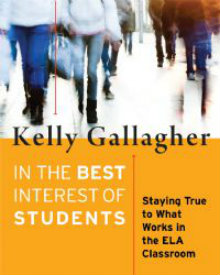Gallagher: Staying True to What Works in ELA
In the Best Interest of Students: Staying True to What Works in the ELA Classroom
By Kelly Gallagher
(Stenhouse Publishers, 2015 – Learn more)

Each year in my classroom, the chasm grows wider between the skills and knowledge my students need to develop to move forward and what standardized test proponents think students should be able to regurgitate to demonstrate ‘proficiency’ or ‘achievement.’
With every new adoption of standards, language arts and English educators across the country dive into a massive, frenzied realignment as they try to decide which components of reading, language, writing and speaking skills are most important to teach in what order. This constant tailspin has come to be seen as a side effect of the modern American educational system.
Getting beyond the standards frenzy

The veteran educator, whose thoughtful work over the last few years has informed, inspired and invigorated reading instruction at all levels, not only thinks so, his In the Best Interest of Students: Staying True to What Works in the ELA Classroom provides intelligent insights to back up his reasoning. Best of all, it includes a wealth of engaging methods to bring reading instruction to life.
A rich mix of perspective, research & practical advice
Gallagher’s first chapter provides a spot-on analysis of three lessons educators can learn from the standards movement and its impact on student learning. From there, he launches into a good news/bad news-type format, highlighting what the current standards both bring to the table in the name of academic improvement and what they lack in addressing student needs.
Chapters two and four expand on the good news portion of Gallagher’s findings as they relate to the teaching of reading and the teaching of writing, respectively. After a quick grounding in the anchor standards, he wastes no time in launching into the heart of what I love most about a Gallagher text: the fresh, classroom-tested methods (always accompanied by quality student exemplars) guaranteed to jump start deeper student learning, engaging classroom conversation and meaningful writing output.
Many of these ideas are so simple yet powerful they can be implemented immediately in class. You’ll find no dense, dry theory here, only activities you can literally try tomorrow in class.
On the other side of the coin, chapters three and five are laser-focused on where the Common Core Reading (chapter 3) and Writing (chapter 5) Standards fail to move students toward becoming lifelong readers and writers. These are not the agitated musings of a teacher who’s simply railing against new standards, but research-based points that reveal the real damage that aspects of the CCSS are doing in the classroom.
Connecting these consequences to real-world examples is a strength of the text as they lead professionally trained teachers to stop and think long and hard about their own classroom reading and writing instruction.
Answers to your “what-next” questions
As chapter five wraps up, Gallagher doesn’t leave teachers scratching their heads about what to do next. Instead, he provides three chapters chock-full of solid, useable methods, guidelines and timeline suggestions that form a plan for ideal reading and writing instruction.
Through examples, Gallagher again stresses the importance of using models to improve student reading and writing and to fine-tune listening and speaking skills. Before he’s done, he answers just about every ‘what next?’ question that may have popped up over the beginning portion of the book. You’re not left hanging and wishing; you’re given expert guidance to make your own instructional practices come to life.
At the risk of sounding sensationalistic, I am sure your teacher brain will not think of the standards movement the same after you finish In The Best Interest of Students. You’ll have a new appreciation for the value of quality standards, a critical consideration of current flaws, and a renewed passion for what matters most: making a genuine difference in the lives of your students despite the ever-growing pressure of test results, standards checklists and assessment consequences.
Read an excerpt from Gallagher’s book, here at MiddleWeb.
Beth Morrow is a veteran middle school ESL/Reading/LA teacher, education blogger and summer camp program director in Columbus, OH. Her work has appeared in a number of books, magazines and blogs for over two decades. She blogs on the value of balancing teaching with life at Morrow In The Middle and tweets with educators @BethFMorrow.



































Thank you for this great review. I am always curious about a new Gallagher text. Since Gallagher teaches high school English, are his examples and teachings geared towards the high school teacher/classroom? Are his methods easily accessible for a middle school (6th grade) ELA teacher? Thank you.
Thanks, Justin–great question. Gallagher’s methods are definitely applicable to middle school ELA classrooms. In fact, the day after reading one of the activity suggestions, I tried it in class and it was a hit. I teach 6-8 ESL ELA, so if it works in my class, it should work for others.